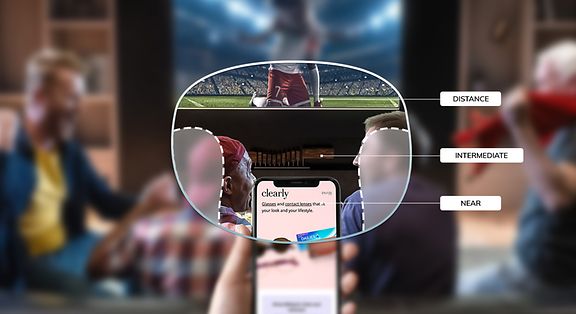What are progressive lenses?
Progressive lenses provide comprehensive vision correction within one lens, with no visible line on the surface. This allows you to see clearly during routine activities without constantly switching between pairs.

Progressive lenses provide comprehensive vision correction within one lens, with no visible line on the surface. This allows you to see clearly during routine activities without constantly switching between pairs.

Distance prescription in the top portion helps you see far-off objects. Middle portion provides a smooth transition and clear intermediate (arm's-length) vision. Near prescription in the bottom portion helps you see at a book reading distance.
When to wear progressive lenses
Glasses with progressive lenses help correct presbyopia, which typically begins to affect people in their 40s and makes it hard to see close objects. Progressives cover multiple vision needs within one lens.

Choose progressives for near distance vision when you're reading, crafting, or need all ranges of vision on the go. For dedicated reading or close-work activities, consider a pair of reading glasses.

Progressive lenses will also help you see clearly at intermediate (arm's-length) distances, ideal for grocery shopping and coffee dates. For dedicated screen-time work, choose Computer Progressives.

The distance portion of progressive lenses helps you see far objects clearly, suitable for driving and walking.
632 Results
Every eye is different and every person is unique. Usually, most people acclimatize to Standard Progressive lenses within two weeks of full-time wear. Premium Progressive lenses tend to have a shorter adaptation period and are easier to get used to.
Remember, giving yourself time for adaptation is critical. Ideally, you should wear them all day – the more you wear them, the faster your adaptation should be.
When you receive your glasses, ensure they’re adjusted by a professional and then try to wear them as much as possible. If everything is blurry when you put them on, contact us right away. If you put them on and they feel a little weird? Great! That’s normal.
Segment height is the point at which the magnification begins for intermediate and near vision.
It’s measured from the centre of your pupil to the lowest point, where the lens meets the frame.
Our system dynamically scales the segment height based on the frame you choose to ensure you enjoy the clearest vision for all the things your eyes do during the day.
Learn more about segment height on our blog.
The main difference between bifocals and progressives is the comprehensiveness of vision correction they provide and the look of the actual lens.
Progressives provide vision correction across all ranges of vision, allowing you to see comfortably at near, intermediate, and far distances. They don’t have a visible line and tend to be a more popular option because of convenience and cosmetic appeal.
Bifocal lenses only provide distance and near vision correction, with a visible line on the surface of the lens that divides the two prescriptions.
Progressive lenses are most often prescribed to people 40 years and older with an 'ADD power' on their prescription. Your eye contains a natural crystalline lens that is flexible — allowing muscles to control its shape and focus on nearby objects when those muscles pull on it.
As we age, that natural crystalline lens stiffens (just like the rest of our bodies!) and becomes less flexible. Around the age of 40, your eye muscles can’t pull hard enough anymore to flex that lens — this is where a progressive lens adds magnification to do some of the work that stiff crystalline lens can’t do anymore.
Presbyopia happens to everyone and it’s unavoidable. Signs of presbyopia can manifest as early as 35 years of age. Consult our eye care professional to find out if your eyes are trying to fulfill a mission impossible and giving you a headache in the process!